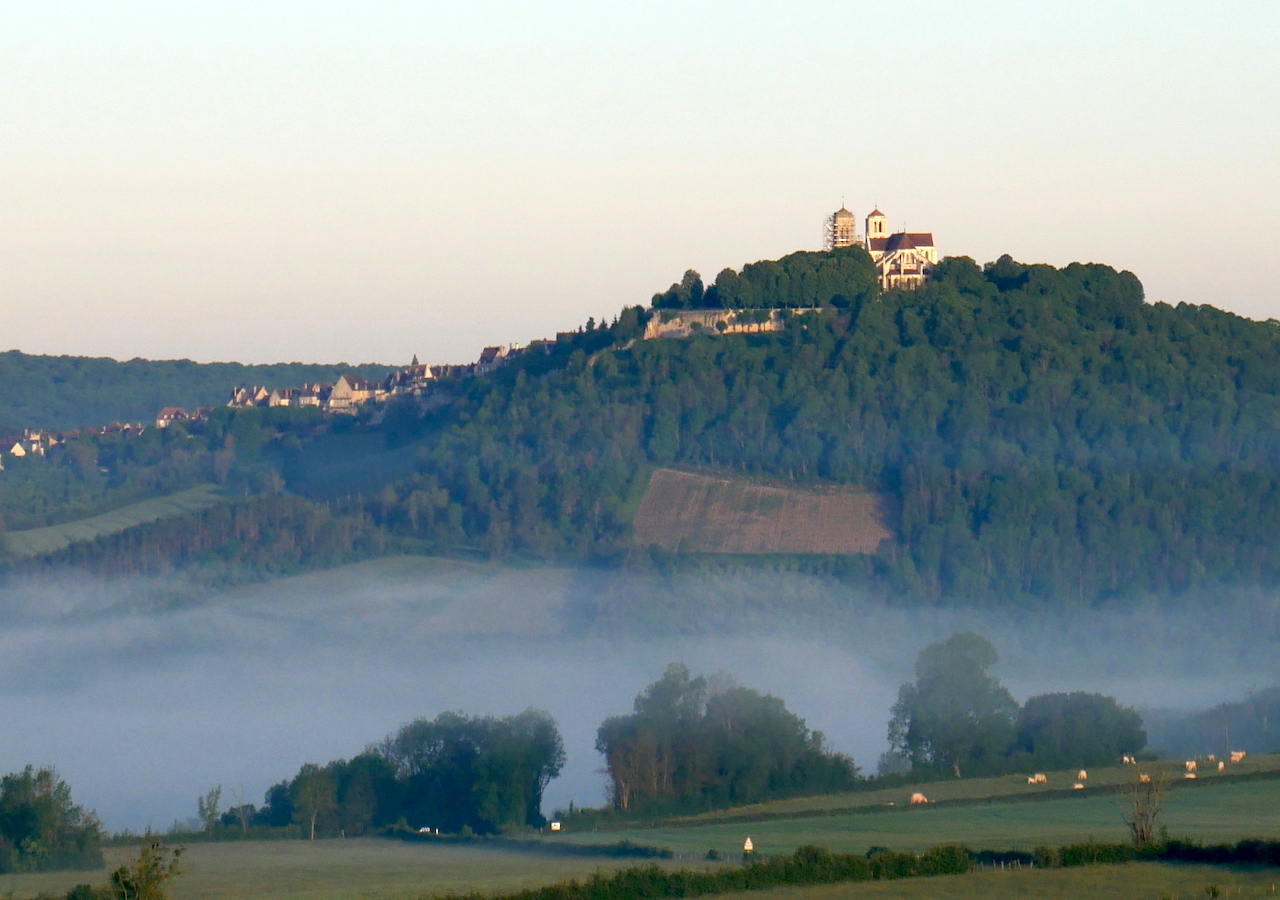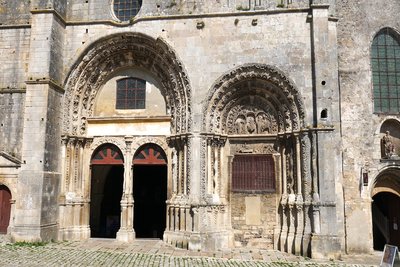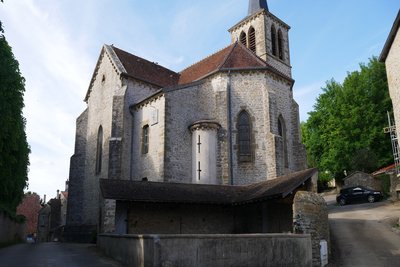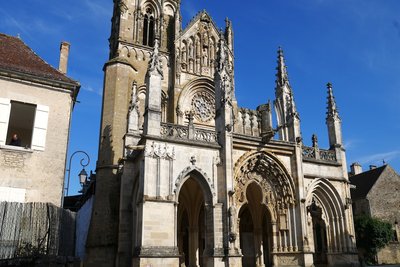Avallon to Vézelay

Bourgogne-Franche-Comté
3. Avallon to Vézelay
Easy
4h30
17,8km
+446m
-411m
Step
Embed this item to access it offline
You leave Avallon by the Cousin valley to cross forests and cereal crops, a short break at Tharoiseau before resuming your pilgrimage to Vézelay.
Soon, the hill and the basilica of Sainte-Marie-Madeleine will take shape in the landscape but take time to visit the church of Saint-Père before climbing the hill through the vineyards of Vézelay.
A stage of communion and grace for all believers.
Soon, the hill and the basilica of Sainte-Marie-Madeleine will take shape in the landscape but take time to visit the church of Saint-Père before climbing the hill through the vineyards of Vézelay.
A stage of communion and grace for all believers.
5 points of interest

Porche d’entrée de la Collégiale Saint-Lazare - Amis saint Colomban TouristSaint-Lazare Collegiate Church in Avallon
Of ancient origin, it was the chief town of a subdivision of the bishopric of Autun. Count Gerard or Girard would have wanted its creation. As was customary, the church was located within the castle walls to prevent any coup de force. Of this primitive 5th century church, placed under the name of Notre-Dame, only a small crypt remains, found in 1861 under the choir.
Shortly after the year 1000, it received a relic of Saint Lazarus from Henry the Great, Duke of Burgundy. It kept the name "Notre-Dame" until 1146, before taking the name "Saint-Lazare" (there was talk of Saint-Ladre in the 16th century). The collegiate church was then crowded with pilgrims on their way to Santiago de Compostela, attracted by the relic of Saint Lazarus.
In 1080, the building was rebuilt and its plan is reminiscent of the old basilicas. "The quarter-spherical vaulted choir, the semicircular arcades, the two semi-circular chapels and part of the side aisles date from this period. It was Pope Paschal II himself who came to consecrate the new church in 1106.
In the 12th century, the abbey of Cluny, on which the church of Avallon depended, had a very beautiful facade built, of which only two portals remain.
Tour Gaujard (XVe siècle) et la Petite Porte d’Avallon - Amis saint Colomban HistoricalThe ramparts of Avallon
The ramparts of Avallon were defended by about twenty towers. Five of them have been preserved: the Beurdelaine tower, the Vaudois tower, the Chapter tower, the Escharguet tower and the Gaujard tower. The two-storey, half-round Escharguet tower, built before the 15th century, had a watchtower that no longer exists today. In the Middle Ages, there was a lookout, ordinary surveillance, and a reinforced surveillance, the escarguet. This term indicates that it was a watchtower.
The Escharguet tower was very quickly transformed into a dwelling. Already in 1522, it was given for one percent less per month to the surgeon called by the city to treat the plague victims."
In 1735 or 1755, the town's cowherd lived there, "hence the name tour de la Vachère, which sometimes refers to it."
In 1572, it houses the artillery store. In 1592, the first floor is filled with earth and bundles to prevent possible explosions.
This private property, located at the intersection of rue de la Vachère and rue Basse du Rempart, cannot be visited.
Information from the information panel placed on the tower and from the brochure of the Association des Amis du Vieil Avallon: "Les Fortifications d'Avallon".
Église Notre-Dame de la Conception à Tharoiseau - Amis saint Colomban TouristNotre-Dame Church in Tharoiseau
Kirche Unserer Lieben Frau von Tharoiseau Seit dem 9. Jahrhundert wird die Stadt Tharoiseau in Dokumenten erwähnt. Um sich vor den Einbrüchen der Mauern zu schützen, wurden im 16. Jahrhundert einige Überreste der Mauern errichtet, von denen heute noch einige sichtbar sind. Die im 19. Jahrhundert wiederaufgebaute Burg liegt im Zentrum des von hohen Mauern umgebenen Dorfes und wird nicht besichtigt.
Die Kirche Notre-Dame de la Conception wurde im 19. Jahrhundert an der Stelle einer Kapelle errichtet. Die Pfarrei wurde im 17. Jahrhundert gegründet, bevor das Dorf der Pfarrei Saint-Père angegliedert wurde.
Église Notre-Dame à Saint-Père-sous-Vézelay - Amis saint Colomban TouristNotre-Dame Church in Saint-Père-sous-Vézelay
Traces of human occupation have existed for several thousand years before the Christian era. The presence of salt springs may explain this occupation dating back to the Mesolithic period. The remains of the Gallo-Roman period can be visited today at the exit of the town (two kilometres from the church on the D 958).
The first Saint-Pierre church, which gave the name to the town, dates from the foundation of the abbey of Vézelay (around 860). A 15th century chapel occupies the site of this first church.
The present church was begun, according to Viollet-le-Duc, in 1240, probably by the abbey of Vézelay. Parts of the church date from the 13th century, others from the 14th or 15th century.
Façade de la basilique de Vézelay - Amis saint Colomban HistoricalThe Basilica of Sainte-Marie-Madeleine of Vézelay
Vézelay was a major centre of Christianity in the Middle Ages and an important place of pilgrimage on the pilgrimage route to Santiago de Compostela.
Built between 1120 and 1150, the basilica of Vézelay is a major building of Romanesque art. The inner tympanum of the narthex, presenting Christ in glory, is one of the masterpieces of Romanesque sculpture.
Rebuilt at the end of the 12th century, the choir has a Gothic style which increases the luminosity of the basilica and contributes to reinforce its symbolism around the theme of divine light. By passing from the narthex to the nave and then to the choir, the visitor progresses from a dark space to an increasingly luminous one, illustrating the inner transformation of the faithful. Moreover, each year at the summer solstice, when the sun is at its highest point in relation to the earth, the light coming from the south windows projects a line of light points in the middle of the nave with rigorous precision.
The basilica is classified as a Historic Monument by the list of 1840. In 1979, it was inscribed on the UNESCO World Heritage List.
Since 1993, the liturgical service has been provided by the monastic fraternities of Jerusalem. Services take place several times a day.
Vézelay Basilica: Wikipedia
Description
Leave the church of Avallon by the left, rue Bocquillot, after the door turn right, cross the parking lot, take the road, left rue du Fort Mahon, right, Route Cousin Le Pont for 20 meters.
- Take the stairs on your left, on your right Pavé de Cousin le Pont, cross the square on the left take the bridge over Le Cousin, Route des Châtelaines, D 127
- First road on the right, chemin des Coignots then on the left, dirt road, on the right path in the wood then first path on the left, straight ahead at the exit of the forest cross the tarred road, rue de la Fontaine, first dirt road on the right before La Courcelle.
- Cross the Ru d'Island, on the left, rue Joseph Montenat, at the exit Le Grand Island turn right and then right again on the dirt road, cross the D 53.
- At the junction with D 71 on the right, Tharoiseau on the left, rue Sous les Murs, first dirt road on the left, pass in front of the pond, first road on the left, on the right crossroads D 36 on the right, Saint-Père
- Turn left on the Cure bridge, right on rue du Colombier, at the junction with the Grande Rue turn right onto the D 958.
- Two dirt tracks on the left, on the right between the vineyards, cross the road, turn left and then right, left Chemin de la Corderie.
- Turn right on Route de Clamecy, first right on Saint-Étienne Street and Saint-Pierre Street and you will arrive at the Sainte-Marie-Madeleine Basilica.
- Departure : Saint-Lazare Church, 15 Rue Bocquillot, 89 200 Avallon
- Arrival : Basilica of Saint Mary Magdalene, place de la Basilique, 89 450 Vézelay
- Towns crossed : Bourgogne-Franche-Comté
Altimetric profile
Transport
Report a problem or an error
If you have found an error on this page or if you have noticed any problems during your hike, please report them to us here:
Close by8
- Information
Information
La Maison du Visiteur in Vézelay
The rich heritage of Vézelay requires information and guidance in the basilica. You present the architecture, the tympanum and reading the capitals is the objective of this association which makes you discover the messages of the builders addressed to the pilgrims in the Middle Ages.








